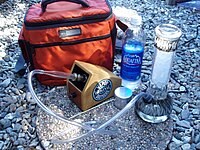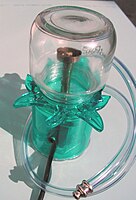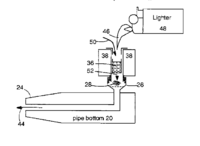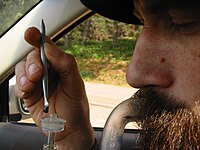Vaporizer (inhalation device)
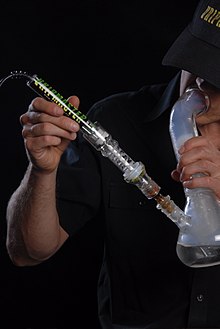
A vaporizer or vaporiser, colloquially known as a vape, is a device used to vaporize substances for
Vaporizers contain various forms of extraction chambers including straight bore, venturi, or sequential venturi, and are made of materials such as metal or glass. The extracted vapor may be collected in an inflatable bag, or inhaled directly through a hose or pipe. When used properly, cooler temperatures due to lack of combustion[3] result in significantly more efficient extraction of the ingredients. Hence, the irritating and harmful effects of smoking are heavily reduced,[4][5][6][7][8] as is its secondhand smoke.
Cannabis vaporizers
Cannabis flower is commonly consumed using a dry herb vaporizer. The cannabis may be heated in a chamber via indirect flame exposure or an electrical heating element, allowing users to inhale the resulting vapor. The temperatures reached are cooler than the combustion temperature of cannabis, which is around 230–315 °C (445–600 °F).[9]
Vaporizing is more efficient than smoking, because approximately 30% of THC in cannabis or hashish cigarettes is destroyed by pyrolysis during smoking.[10]
Cannabis is also consumed via the vaporization of
Cannabis concentrate is also commonly used in e-cigarette style vaporizer pens in the form of liquid containers known as cartridges. A
-
Vaporizer with water-cooling
-
A conduction-style vaporizer
-
A passive-convection "vaporization pipe" with flame filter
-
A man inhaling cannabis concentrate vapor from a dab rig
-
New York State Department of Health image showcasing a variety of THC vapes and packaging
Of the studies that have investigated cannabis vaporization, few have addressed the quality of the vapor extracted and delivered; instead, studies usually focus on the mode of usage of the vaporizers. However, those that have addressed vapor quality have demonstrated promising results. Such studies suggest that the absence of combustion results in an aerosol that contains significantly lower amounts of harmful substances found in smoke, such as tar, carbon monoxide, and carcinogenic compounds known as polynuclear aromatic hydrocarbons (PAH).[14][9][15] One study found that cannabis smoke contains 111 compounds (including several carcinogenic PAHs) in addition to the cannabinoids, whereas only 3 additional compounds were identified in cannabis vapor, other than the cannabinoids.[9] This suggests that the vaporization of cannabis may be a safer alternative to combusted cannabis.[16] On the other hand, a study in the UK (where cannabis is illegal) found that some illicitly distributed cannabis vaporizers contained harmful levels of xylazine, an animal sedative which can lead to overdose.[17]
E-cigarette vaporizers

An electronic cigarette is a handheld
The benefits and the
Other drug
Vaporizers can be used to inhale other recreational drugs as well. A wide variety can be consumed this way, either dissolved in e-liquid or vaporized directly.[54] The use of e-cigarettes to inhale the psychedelic drug DMT has been reported.[55]
Medical vaporizers
Studies have shown that vaporizing cannabis exposes the user to lower levels of harmful substances than smoking cannabis.
In a study published in the Journal of Psychopharmacology in May 2008, it was stated that vaporizers were a "suitable method for the administration of THC".[60] A 2007 study by the University of California, San Francisco, published in the Journal of the American Academy of Neurology, found that "there was virtually no exposure to harmful combustion products using the vaporizing device".[7] A 2006 study performed by researchers at Leiden University found that vaporizers were "safe and effective cannabinoid delivery system(s)". The study stated that the amount of THC delivered by vaporizers were equivalent to the amount delivered by smoking.[58] Because of those studies and other studies, vaporizers are considered medically sound devices for delivering THC.[14]
Efficiency
The proposed factors affecting output include:[9][58]
- Temperature
- Specimen density
- Weight, content of water and essential oils
- Consistency of material in the filling chamber
- Storage time of the vapor
- Inhalation method (breathing technique)
Not all those have been scientifically tested. Research using vaporizers found the delivery efficiency highest at around 226 °C (439 °F), falling to about half efficiency at 150 to 180 °C (302 to 356 °F) depending on material.[58] The purest preparations produced the highest efficiencies, about 56% for pure THC versus 29% for plant material (female flower tops) with 12% THCA content. Besides THC, several other cannabinoids as well as a range of other plant components including terpenoids were detected in the plant material. Using pure THC in the vaporizer, no degradation products (delta-8-THC (D8-THC), cannabinol (CBN), or unknown compounds) were detected by HPLC analysis.[58] The longer vapor is stored, the more THC is lost as it condenses on the surface of the vaporizer or the balloon. This loss may be negligible over a few minutes but may exceed 50% after 90 minutes.[58] The Leiden University study found that as much as 30–40% of inhaled THC was not absorbed by the lungs but simply exhaled. However, they did not find large individual differences in the amounts exhaled.[58]
Culinary application
Vaporizers are sometimes used by chefs as a method of applying controlled heat to herbs and spices to release flavors that are otherwise difficult to titrate or apply, or that might be spoiled by overheating during cooking.[61][62][63] Grant Achatz, chef-proprietor of Alinea in Chicago, "uses the aroma-filled bags as place-mats, punctured when plates are placed in front of the customer".[61]
See also
- Anesthetic vaporizer
- Aromatherapy
- Chasing the dragon
- Eagle Bill
- Nebulizer
Bibliography
- Wilder, Natalie; Daley, Claire; Sugarman, Jane; Partridge, James (April 2016). "Nicotine without smoke: Tobacco harm reduction". UK: Royal College of Physicians. pp. 1–191.
- "Electronic nicotine delivery systems" (PDF). World Health Organization. 21 July 2014. pp. 1–13.
References
- PMID 33746051.
- PMID 33116348.
- ISBN 978-1560534426.
- PMID 17437626.
- ^ "Vaporizers for Medical Marijuana". www.aids.org. Archived from the original on 2010-07-18. Retrieved 2008-07-28.
- .
- ^ S2CID 14629288.
- PMID 17821306.
- ^ . Retrieved June 20, 2010.
- ^ Marilyn A. Huestis; Michael L. Smith (2007), "Human Cannabinoid Pharmacokinetics and Interpretation of Cannabinoid Concentrations in Biological Fluids and Tissues", in Mahmoud A. ElSohly (ed.), Marijuana and the Cannabinoids, Humana Press, pp. 205–235
- ^ "Vaping & Marijuana Concentrates" (PDF). Drug Enforcement Administration. 2020. Retrieved 2023-10-28.
- PMID 34448130.
- PMID 34368078.
- ^ .
- S2CID 14629288.
- PMID 26078621.
- ISSN 0261-3077. Retrieved 2024-04-10.
- S2CID 207223131.
- ^ PMID 25731134.
- PMID 24732157.
- PMID 25089953.
- PMID 25745382.
- PMID 24259045.
- PMID 28961314.
- PMID 25156991.
- ^ Hayden McRobbie (2014). "Electronic cigarettes" (PDF). National Centre for Smoking Cessation and Training. pp. 1–16.
- PMID 24569565.
- ^ Konstantinos Farsalinos. "Electronic cigarette evolution from the first to fourth generation and beyond" (PDF). gfn.net.co. Global Forum on Nicotine. Archived from the original (PDF) on 8 July 2015. Retrieved 23 September 2015.
- PMID 25794473.
- S2CID 10560264.
- PMID 26668136.
- ^ Wilder 2016, p. 82.
- PMID 25572196.
- PMID 26389730.
- PMID 24898072.
- PMID 25515689.
- PMID 26648633.
- ^ a b WHO 2014, p. 6.
- ^ "E-Cigarette Use Among Youth and Young Adults A Report of the Surgeon General: Fact Sheet" (PDF). Surgeon General of the United States. 2016.
 This article incorporates text from this source, which is in the public domain.
This article incorporates text from this source, which is in the public domain.
- ^ Stratton 2018, p. Summary, 16.
- ^ PMID 24575993.
- PMID 21150942.
- PMID 25410845.
- PMID 24406205.
- PMID 23741941.
- PMID 33913154.
- S2CID 54566712.
- PMID 30464018.
- PMID 27191672.
- PMID 25089952.
- PMID 24821826.
- ^ Edgar, Julie (12 November 2013). "E-Cigarettes: Expert Q&A With the CDC". WebMD.
- ^ "Outbreak of Lung Illness Associated with Using E-cigarette Products". Centers for Disease Control and Prevention. 28 January 2020.
 This article incorporates text from this source, which is in the public domain.
This article incorporates text from this source, which is in the public domain.
- PMID 29051432.
- ^ Power M (2020-06-05). "I Sell DMT Vape Pens So People Can 'Break Through' at Their Own Speed". www.vice.com. Retrieved 2020-07-12.
- ^ "Marijuana Vaporizer Provides Same Level Of THC, Fewer Toxins, Study Shows", Official Journal of the American Academy of Neurology (summarized by Science Daily) (2007-05-16)". Sciencedaily.com. 2007-05-16. Retrieved 2011-02-23.
- ^ "Cal NORML/MAPS Study Shows Vaporizer Can Drastically Reduce Toxins in Marijuana Smoke". Canorml.org. Retrieved 2011-02-23.
- ^ PMID 16637053.
- ISBN 978-1455771226.
- S2CID 6094814.
- ^ a b Bob Gledhill (22 August 2007). "Alinea restaurant uses Volcano as flavorizer". Caterersearch.com. Retrieved 2011-02-23.
- ^ "Tools for creating aromatic flavors". Chow.com. 2007-01-18. Retrieved 2011-02-23.
- ^ "Volcano used to release nutmeg aroma". Rimag.com. Archived from the original on 2009-01-24. Retrieved 2011-02-23.

